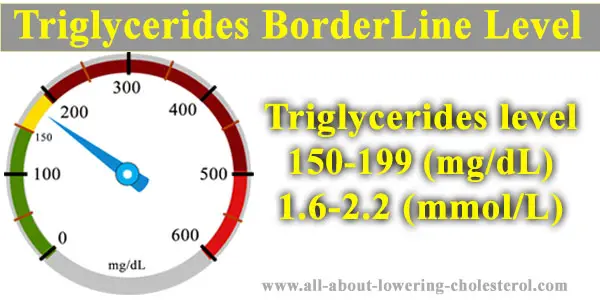
Triglyceride levels of 150-199 mg/dl is considered borderline. This means that it is above the normal range, but not quite in the high range yet.
The causes of such triglyceride levels are obesity, poorly controlled diabetes, drinking alcohol, consuming regularly more calories than you burn, some drugs, heredity, genetics, kidney disease, hypothyroidism, etc.
To people with no risk factors for cardiovascular disease, borderline triglycerides pose to risk for the health. But on the contrary, in people with risk factors, the probability of developing cardiovascular disease, strokes, peripheral arterial disease, or other complications multiplies.
What does having triglyceride level 150-199 mg/dl mean?
Triglycerides are a type of lipid found in the body. When we eat, our body stores the excess energy in the form of triglycerides to use later when it is needed. People commonly mistake triglycerides with cholesterol but they are not the same thing.
Both triglycerides and cholesterol are lipids, but only triglycerides are fats. Cholesterol is a waxy substance used by your body for many important functions, such as building the membranes of the cells and producing some important hormones, whereas triglycerides are used by the body for energy.
Triglycerides are important for overall health, but they must be kept within the normal ranges. High triglyceride level is bad for the health. Triglyceride levels of 150-199 mg/dl are considered borderline, which means that its levels are higher than normal, but not quite in the high range yet.
Triglyceride level 150-199 mg/dl – What are the levels of risk for cardiovascular disease?
Triglyceride level of 150-199 mg/dl is considered borderline. Such triglyceride level poses no threat to developing cardiovascular disease in people with no other risk factors (such as hypertension, diabetes, high cholesterol levels, heredity, age, etc.).
In people with at least one of the aforementioned risk factors of cardiovascular disease, a triglyceride level of 150-199 mg/dl increases the possibility of developing cardiovascular disease.
The mechanism is the same as it is with high cholesterol levels: Triglycerides contribute to the development of the plaques in the walls of the coronary arteries. These plaques narrow the inner space of the artery, by diminishing the blood flow that supplies the heart muscle with blood.
Less blood means less oxygen, and, therefore, the heart muscle starts to suffer from the lack of oxygen. This causes chest pain, and can even cause death.
Triglyceride level 150-199 mg/dl – What are the risks for any other health problems?
Triglyceride levels of 150-199 mg/dl can increase the risk of other health problems, in people with prior risk factors. The main health problems such triglyceride levels can cause are:
1. Peripheral artery disease – The mechanism is the same as it is in cardiovascular disease, the only difference is that the pathogenic process does not affect the coronary arteries, but it affects the arteries of the lower and upper limbs, mostly the arteries of the legs.
2. Strokes – It is the affection of the brain arteries, causing numerous symptoms which depend on the affected area.
In people with no risk factors, borderline triglyceride level poses no risk for their health.
Triglyceride level 150-199 mg/dl – What can be the causes?
The main causes of triglyceride level 150 -199 mg/dl are as following:
· Obesity
· Poorly controlled diabetes
· An underactive thyroid (hypothyroidism)
· Kidney disease
· Regularly eating more calories than you burn
· Drinking a lot of alcohol
· Genetic
· Some drugs(Tamoxifen, steroids, beta-blockers, diuretics, estrogen, birth control pills )
The management of triglyceride levels is based on treating/managing the primary cause. So, quitting alcohol, trying to lose weight, controlling diabetes/hypothyroidism/kidney disease, etc. can bring the triglyceride levels back to the normal range again.
